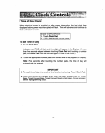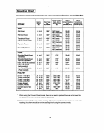
General Baking Recommendations
0 When cooking foods for the first time in your new oven, use recipe cooking times
and temperatures as a guide.
0 Use tested recipes from reliable sources.
0 Preheat the oven only when necessary. For baked foods that rise and for richer
browning, a preheated oven is better. Casseroles can be started in a cold oven.
Preheating takes from 7 to 11 minutes; place food in oven after PREHEAT Indicator
Word cycles off.
0 Arrange oven racks before turning on oven. Follow suggested rack positions on
page 9 and in various baking charts.
0 Allow about 1 to 1% inches of space between the oven side walls and pans to allow
proper air circulation.
0 When baking foods in more than one pan, place them on opposite corners of the
rack.
Stagger
pans
when baking on two racks so that one pan does not shield
another unless shielding is intended. (See above left)
0 To conserve energy, avoid frequent or prolonged door openings. At the end of
cooking, turn oven off before removing food.
0 Always test for doneness (fingertip, toothpick, sides pulling away from pan). Do not
rely on time or brownness as only indicators.
0 Use good quality baking pans and the size recommended in the recipe.
0 Dull, dark, enameled or glass pans will generally produce a brown, crisp crust. Shiny
metal pans produce a light, golden crust.
0 Frozen pies in shiny aluminum pans should be baked on a cookie sheet on rack 2
or be removed to a dull or glass pan.
0 If edge of pie crust browns too quickly, fold a strip of foil around rim of crust, covering
edge. (See above right.)
NOTE:
A cooling fan will operate during all cooking modes. The fan may also continue
to operate after the oven is turned off until the oven has cooled down.
14


















